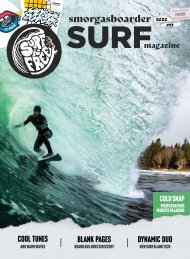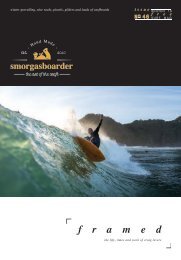SB-issue59_digital
You also want an ePaper? Increase the reach of your titles
YUMPU automatically turns print PDFs into web optimized ePapers that Google loves.
gear<br />
performance. Bob has been quoted as saying, “A lot of people<br />
ask me about volume. They think they’ve got to match their body<br />
weight to a certain volume.<br />
“The Archimedes’ principle says that you’ve got to have<br />
something underwater to displace water and create buoyancy.<br />
Buoyancy is the result of submersing mass. So, if you put extra<br />
inches on the deck, it’s doing zero. It’s giving you volume, but<br />
it’s not floating you. It’s got to be submerged to float you.”<br />
Bob goes on to explain that there are so many other aspects of<br />
surfboard design that surfers should focus on rather than just<br />
volume, such as width, rockers, and concaves.<br />
“You’ve got to have a wider board to float you better than a<br />
narrow one because you add inches that submerge.<br />
(because they surf so well on little boards), the surf industry (for<br />
making it cool to surf on little boards), and the developing surfers<br />
themselves (for believing the hype around small boards).<br />
“The biggest misconception in surfboard design is that you can’t<br />
turn wide boards. One only needs to take a look at guys like Joel<br />
Tudor and Dave Rastovich to see that myth completely busted.<br />
The fact is that, for a developing surfer, it is not the width of<br />
a board that will help them improve their turns, but first and<br />
foremost, it is their technique.<br />
“And how do you improve that technique? By catching plenty<br />
of waves, that’s how. And to catch more waves you are going<br />
to need something to float you — enter width, length, and<br />
thickness into the equation. Add to that the fact that surfing<br />
is first and foremost about fun, and you can’t have any fun let<br />
alone develop your surfing if you’re scratching around on a 6’ 2’’<br />
x 18’’ missing all the waves.”<br />
Greg goes on to explain that it is thanks to the pro surfing<br />
movement that everyday surfers are trying to ride small boards<br />
that are perhaps too small for them. We have to remember that<br />
just because they can, that doesn’t necessarily mean we mere<br />
mortals can.<br />
“Remember, you are not Kelly Slater! This is where surfing differs<br />
from most other sports. If you go and buy yourself the latest<br />
and best tennis racquet, golf clubs or fishing reel, the one used<br />
by all the pros, it is going to help you improve towards that high<br />
standard. Not with surfing. You need the equipment to suit your<br />
body size, ability, and experience. Remember, we don’t all wear<br />
the same size jeans!<br />
“The 90s and early 2000s made surfing small boards cool, and it<br />
has left its legacy on a lot of surfers today. Every time I surf, I see<br />
at least one guy (usually more) that needs a way bigger board<br />
than what they are riding. Much of the time it boils down to not<br />
only the misconception that width is bad, but also the image<br />
side of things. The surf industry directs its surfing equipment at<br />
hotties, and it sweeps up the majority of average surfers with it,<br />
although it has been nice to see the manufacturing companies<br />
starting to make thicker, wider boards again.”<br />
As Greg explains, the reason that guy at your local break rips so<br />
much on a small board is not because of the board, but because<br />
he has a great technique. And, as you get better, you too can<br />
refine your boards in due course.<br />
# 59 // smorgasboarder //<br />
80<br />
“So, thickness is not necessarily the answer to flotation. The<br />
most efficient rockers will flow the water under the board and<br />
bring it back to the surface as you pass through.<br />
“Double concaves will get you up on top of the water as soon<br />
as you start moving the board — and that’s when volume<br />
disappears.<br />
“Once you’re up and planing (running on the wave), volume is<br />
not an issue at all. It’s only water in displacement mode paddling<br />
to catch a wave.”<br />
What I believe Bob is addressing is one of the possible<br />
misconceptions of volume, in that it is considered the be-all<br />
and end-all in relation to bouyancy. It is not just volume that<br />
determines how much your board floats.<br />
It’s a sentiment that resonates with Greg Hogan, master<br />
craftsman, custom shaper, and factory manager at Island<br />
Surfboards in Phillip Island. In the article he penned way back<br />
in Edition 2, he refers to the width of a surfboard along with the<br />
rider’s ability and the types of waves being ridden.<br />
“Size does matter! Whether you’re a 120kg 50-year-old or a<br />
50kg 15-year-old, you are going to need width and length in a<br />
surfboard to help you learn to surf. The width gives buoyancy,<br />
planing area, and stability.<br />
“One of the major mistakes developing surfers make is to<br />
decrease that width to extremes once they have learnt to<br />
surf. The blame for this can be levelled at professional surfers<br />
“The most important thing is to be<br />
completely honest with your shaper<br />
about your ability. They are the ones<br />
who should know what is best for<br />
someone of your size and experience<br />
(if they don’t, time to get a new<br />
shaper), it just takes you to swallow<br />
the ego and admit where you’re at.<br />
Your surfing will thank you for it!”<br />
I’m sorry if we didn’t provide a nice, straightforward answer to<br />
whether volume is important in surfboard design. The harsh<br />
reality is that, while it is handy to know and a good starting<br />
point, it is an aspect of design that can form part of your<br />
decision-making process, but it is far from a guiding principle<br />
in determining what surfboard is right for you. In our opinion, it<br />
should never be isolated from other design factors.
















